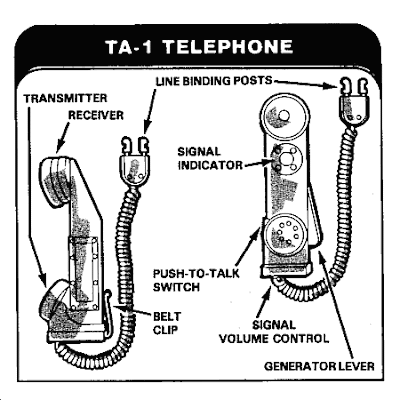http://sipseystreetirregulars.blogspot.com/2012/06/praxis-field-wire-field-telephones.html
Field telephones are mobile telephones intended for military use, designed to withstand wartime conditions. They can draw power from their own battery, from a telephone exchange (via a central battery known as CB), or from an external power source. Some need no battery, being sound-powered telephones. Field telephones were first used in the First World War to direct troops. They replaced flag signals and the telegraph as an efficient means of communication. The first field telephones had a wind-up generator, used to power the telephone's ringer & batteries to send the call, and call the manually-operated telephone central. This technology was used from the 1910s to the 1960s. Later the ring signal has been made electronically operated by a pushbutton, or automatic as on domestic telephones. The manual systems are still widely used, and often compatible with the older equipment. -- Wikipedia.


In addition, half of my field telephones are sound-powered TA-1s, which require no batteries. The other half are TA-312s (or the earlier version, TA-43s) which although are designed to be battery-operated on two D-cells can also be operated without them using the sound-power principle.
The TA-1/PT, built to US military specifications, is a one-piece sound-powered field telephone for use on two-wire field lines in forward tactical areas. It can communicate with other field telephones or field and fixed-base LB switchboards. The TA-1/PT is equipped for transmission signaling with a built-in signal generator and for receive signaling with an audible buzzer and volume control. Additionally, a visual indicator on the handset is utilized for silent receive signaling. The set is carried in an all-weather carrying case with shoulder strap, or attached to a field belt with an integral belt clip. Voice transmission range is 6.4 km with WD-1/TT field wire. The set weighs 0.8 kg with carrying case. Signal voltage is 20 Hz, 65 to 80 V. -- Jane's Military Communications.

TA-312 field telephone.
Built to US military specifications, the TA-312A/PT telephone set is a two-wire, battery-operated tactical system. It can be used as a point-to-point Voice Frequency (VF) wire communications link or in any two-wire ringdown subscriber positions of a telephone communications system. The 4.2 kg telephone set is ruggedised for all-weather field communications requirements, and can be utilized as a desk- or wall-mounted telephone in fixed or mobile military shelters or command posts requiring intercommunications between shelters and field operations. The TA-312A is used either as a Local Battery (LB) or Common Battery (CB) manual telephone and can be set up for operation as a local battery telephone, using Common Battery Signaling (CBS). Additionally, the telephone set is used to control remotely operated radio links by operation of the press-to-talk switch on the telephone handset. The TA-312A has special circuits to reduce or clip high-voltage line surges in the receive mode, and side tone balance is maintained over a range of voice frequencies and battery voltages. The TA-312A can be adapted to interface with automatic switchboards, such as the SB-3614 tactical switching centre, by using the optional TA955/PT tone signaling adaptor. Power requirements are two 1.5 V batteries in the LB mode, 48 V DC in the CB mode. -- Janes Military Communications......

Much more at the link that I first posted. Please click the link to see and read it all.
Anybody have much experience with all of this?